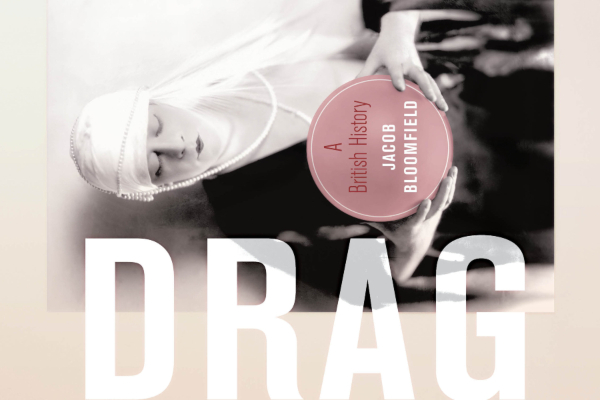Words by Eric Page
One of the great joys of this book is the delightful stories unearthed, along with the academic rigour in the uncovering and presentations of some of history’s great drag performers. Mostly unremembered now, but enormously popular during their time, ‘national treasures’ in many ways and completely integrated into the life of the theatre and expectations of the paying public.
Bringing these wonderful characters, and their quotes, to our gayze is a joy and Bloomfield is to be danced around the block for taking such care to present these lives in context, while always keeping a shady focus on the drag, or female impersonation as it’s often been framed.
 I loved reading about how in 1906, American drag entertainer and vaudeville star Julian Eltinge travelled to England, performing for an enraptured King Edward VII at Windsor Castle, or the Les Rouges et Noirs, the drag troupe composed of men who fought in the First World War and was the subject of the second ‘talkie’ film produced in Britain. The length of their performances, the love letters sent to them, their acts of heroism during the war, all delightful.
I loved reading about how in 1906, American drag entertainer and vaudeville star Julian Eltinge travelled to England, performing for an enraptured King Edward VII at Windsor Castle, or the Les Rouges et Noirs, the drag troupe composed of men who fought in the First World War and was the subject of the second ‘talkie’ film produced in Britain. The length of their performances, the love letters sent to them, their acts of heroism during the war, all delightful.
Drag was always a focus of public discussions around gender – from Victorian sex scandals to the ‘permissive society’ of the 1960s. This book deftly demythologizes drag, stressing its ordinariness, contextualising its performers, while affirming its important place in British cultural heritage. It many examples of establishment drag performers a full bellied clarion call against those who would suggest drag is a modern phenomenon.
 This wide, diverse breadth of drag performers and personas who appear continuously, without pause throughout British history from the early 17th century is testament to their popularity with the public. Even the great Wars of the 20th century couldn’t stifle drag, in fact it spurred it on to greater heights becoming a welcomed staple of wartime entertainment for the masses. Bloomfield emphatically shows us that drag has persisted as an intrinsic, and common, part of British popular culture despite its transgressive associations.
This wide, diverse breadth of drag performers and personas who appear continuously, without pause throughout British history from the early 17th century is testament to their popularity with the public. Even the great Wars of the 20th century couldn’t stifle drag, in fact it spurred it on to greater heights becoming a welcomed staple of wartime entertainment for the masses. Bloomfield emphatically shows us that drag has persisted as an intrinsic, and common, part of British popular culture despite its transgressive associations.
The book takes us by the manicured gloved hand and chronologically leads us, via clubs, shows, scandals, politics, intrigue, to some rather delicious queer individuals and the way they used drag to succeed and flourish on stage whilst making strong pertinent socially informed humour a expected and publicly adored stage craft. The books opens with an evening at a Drag Revue in the company of the theatrical censor in 1958, giving insight into how the theatre was morally policed before the social revolutions of the 1960s. We learn about where and how performers flourish and how different the perceptions of men dressing up as women were from our current assumptions of Drag=Gay.
 Danny La Rue, the Grand Celtic Dragosaurus, who dominated high camp via formal drag for decades, a sailor from Cork who reinvented himself as 7ft of ostrich feathers, lamé, sequins, and heels and ended up with his own club, shows, TV specials and the longest running panto in the world. Oh yes, he did! All the while pursing his immaculately lippied lips and ‘tutting’ at the ‘permissive society’ appearing around him.
Danny La Rue, the Grand Celtic Dragosaurus, who dominated high camp via formal drag for decades, a sailor from Cork who reinvented himself as 7ft of ostrich feathers, lamé, sequins, and heels and ended up with his own club, shows, TV specials and the longest running panto in the world. Oh yes, he did! All the while pursing his immaculately lippied lips and ‘tutting’ at the ‘permissive society’ appearing around him.
The very short final chapter of the book looks at radical drag and how that’s been reclaimed by queer and gay communities.
Let’s make it clear that this is a British book about British drag and British entitlement and British privilege and a mighty bit of research it is too, the whole of the last third of the book is taken up with notes to all the chapters, bibliographies, index etc. However, the care taken on uncovering and compiling the glorious performers shared within its covers more than makes up for its learned presentation. The choice of font is also on the small side. Choices….
This is a great history of drag in the UK, both comprehensive and hugely informative, sharing not only wonderful stories and revitalising almost lost performers but also politically and sociality contextualising drag and empowering us to make informed observations about the current toxic and utterly fabricated ‘moral panic’ about drag today.
For anyone absorbed in the UK’s relationship with men dressing as female facsimiles for entertainment, this will be the go-to book; for those of us looking to spice up our conversations with delicious almost implausible and sometime jaw-droppingly camp info about drag in days gone by it’s pretty cool poolside reading.
Out now in Hardback, £25.
For more info or to buy the book see the publisher’s website here:
















You must be logged in to post a comment.